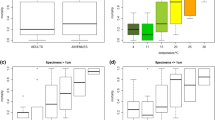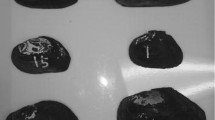Abstract
Limnoperna fortunei (Dunker, 1857) (Bivalvia, Mytilidae) was first reported from Río de La Plata in 1991; soon thereafter, it spread widely throughout the basin, causing great damage to all sorts of water supply systems. The desiccation period that young and adults can tolerate was analyzed in laboratory and outdoor experiments. L. fortunei is tolerant to desiccation. The tolerance increases with size. About 72 h was required to kill small mussels (up to 6 mm), 192 h to kill medium-sized adults (>6–15 mm) and 276 h to kill maximum-sized mussels adults (>15–27 mm) in laboratory exposures, and 72 h, 96 h and 108 to kill small, medium-sized and maximum sized mussels in outdoor exposures. The results have implications for using desiccation to combat the spread of L. fortunei.
Similar content being viewed by others
References
Bechara, J. A., S. Sánchez, J. P. Roux, J. P. Terraes & C. Flores Quintana, 1999. Variaciones del factor de condición relativo de la ictiofauna del río Paraná aguas debajo de la represa de Yacyretá, Argentina. Rev. Ictiol. 7: 75-89.
Bonetto, A. A., 1954. Náyades del río Paraná. El género Diplodon en el biotopo isleño del Paraná Medio e Inferior. Secretaría de Agricultura Ganadería e Industrias de Santa Fe: 1-56.
Bonetto, A. A., 1961. Investigaciones acerca de las formas larvales del género Diplodon y su aplicación a los estudios sistemáticos. Ministerio de Agricultura y Ganadería de Santa Fe: 1-48.
Bonetto, A. A. & I. Ezcurra, 1962. El desarrollo del lasidium de Anodontites trapesialis forbesianus (Lea) (Moll. Lamell.). Physis 23: 195-203.
Claudi, R. & G. L. Mackie, 1994. Zebra Mussel Monitoring and Control. Boca Ratón, Lewis Publishers. 227 pp.
Darrigran, G., 1992. Variación temporal y espacial de la distribución de las especies de Corbicula Megerle, 1811 (Bivalvia, Corbiculidae) en el estuario del Río de La Plata, RepÚblica Argentina. Neotropica 38: 59-63.
Darrigran, G. & G. Pastorino, 1995. The recent introduction of a freshwater asiatic bivalve, Limnoperna fortunei (Mytilidae) into South America. Veliger 38: 171-175.
Darrigran, G., P. Penchaszadeh & M. C. Damborenea, 1999. The reproductive cycle of Limnoperna fortunei (Dunker, 1857) (Mytilidae) from a neotropical temperate locality. Shellfish Res. 18: 361-365.
Darrigran, G. & I. Ezcurra de Drago, 2000. Invasion of the freshwater mussel Limnoperna fortunei (Dunker, 1857) (Bivalvia: Mytilidae) in South America. Nautilus 114: 69-73.
Di Persia, D. & A. A. Bonetto, 1997. Nuevas citas de Limnoperna fortunei para la cuenca del río Paraná, Argentina. Neotropica 43: 119-120.
Di Persia, D. H. & R. A. D'Angelo, 2000. Limnoperna fortunei (Bivalvia, Mytilidae) en el Alto Paraná Argentino. Rev. Cienc. y Tecnol. 3: 64-70.
Dreher Mansur, M. C., L. M. Zani Richinitti & C. Pinheiro dos Santo, 1999. Limnoperna fortunei (Dunker, 1857), molusco bivalvo invasor, na bacia do Guaíba, Río Grande do Sul, Brasil. Biociencias 7: 147-149.
Ituarte, C. F., 1981. Primera noticia de la introducción de Pelecípodos asiáticos en el área rioplatense. Neotropica 27: 79-82.
Ituarte, C. F., 1989. Los géneros Byssanodonta d’Orbigny, 1846 y Eupera Bourguignat, 1854 (Bivalvia: Sphaeriidae) en el área paranoplatense. Descripción de Eupera iguazuensis n. sp. del río IguazÚ, Misiones, Argentina. Neotropica 35: 53-63.
Iwasaki, K., 1997. Climbing behaviour and tolerance to aerial exposure of a freshwater mussel, Limnoperna fortunei. Venus 56: 15-25.
Jenner, H. A & J. P. M. Janssen-Mommen, 1993. Monitoring and control of Dreissena polymorpha and other macrofouling bivalves in the Netherlands. In Nalepa, T. F. & D. W. Schloesser (eds), Zebra Mussels: Biology, Impacts and Control. Lewis Publishers, Boca Ratón: 537-554.
Le Page, W. L., 1993. The impact of Dreissena polymorpha on waterworks Operations at Monroe, Michigan: a Case History. In Nalepa, T. F. & D. W. Schloesser (eds), Zebra Mussels: Biology, Impacts and Control. Lewis Publishers, Boca Ratón: 333-358.
Mackie, G. L., 1991. Biology of the exotic zebra mussel, Dreissena polymorpha, in relation to native bivalves and its potential impact in Lake St. Clair. Hydrobiologia 219: 251-268.
Montalto, L., O. B. Oliveros, I. Ezcurra de Drago & L. D. Demonte, 1999. Peces del río Paraná Medio predadores de una especie invasora: Limnoperna fortunei (Bivalvia, Mytilidae). Fabicib 3: 85-101.
Morton, B., 1973. Some aspects of the biology and functional morphology of the organs of feeding and digestion of Limnoperna fortunei (Dunker) (Bivalvia: Mytilacea). Malacologia 12: 265-281.
Morton, B., 1977. Freshwater fouling bivalves. Proceedings of the Fish International Corbicula Symposium. Texas, Christian University: 1-14.
Nalepa, T. F. & D. W. Schloesser, 1993. Zebra Mussels: Biology, Impacts and Control. Boca Ratón, Lewis P ublishers, 810 pp.
Pastorino, G., G. Darrigran, S. Martin & L. Lunaschi, 1993. Limnoperna fortunei (Dunker, 1857) (Mytilidae), nuevo bivalvo invasor en aguas del Río de La Plata. Neotropica: 101-102.
Paukstis, G. L., J. K. Tucker, A. M. Bronikowski & F. J. Jansen, 1999. Survivorship of aerially-exposed zebra mussels (Dreissena polymorpha) under laboratory conditions. Freshwat. Ecol. 14: 511-517.
Penchaszadeh, P. E., G. Darrigran, C. Angulo, A. Averbuj, M. Brogger, A. Dogliotti & N. Pírez, 2000. Predation of invasive freshwater mussel Limnoperna fortunei (Dunker, 1857) (Mytilidae) by the fish Leporinus obtusidens Valenciennes, 1846 (Anostomidae) in the Río de La Plata, Argentina. Shellfish Res. 19: 1-3.
Schloesser, D. W., 1995. Introduced species, zebra mussel in North America. In Nieremberg, W. A. (ed.), Encyclopedia of Environmental Biology. Academic Press, San Diego: 337-356.
Smit, H., A. bij de Vaate & A. Fioole, 1992. Shell growth of the zebra mussel (Dreissena polymorpha (Pallas)) in relation to selected physico-chemical parameter in Lower Rhine and some associated lakes. Arch. Hydrobiol. 124: 257-280.
Tucker, J. K., C. H. Theiling, F. J. Jansen & G. L. Paukstis, 1997. Sensitivity to aerial exposure: potential of system-wide drawdowns to manage zebra mussels in the Mississippi River. Regul. Riv. Res. Manage. 13: 479-487.
Villar, C., L. Mercado, A. Rodríguez Capítulo & C. Bonetto, 1997. Presencia del molusco invasor Limnoperna fortunei (Dunker, 1857) (Bivalvia; Mytilidae) en el Bajo Paraná. Gayana Zoología 61: 87-96.
Author information
Authors and Affiliations
Rights and permissions
About this article
Cite this article
Montalto, L., Ezcurra de Drago, I. Tolerance to desiccation of an invasive mussel, Limnoperna fortunei (Dunker, 1857) (Bivalvia, Mytilidae), under experimental conditions. Hydrobiologia 498, 161–167 (2003). https://doi.org/10.1023/A:1026222414881
Issue Date:
DOI: https://doi.org/10.1023/A:1026222414881




